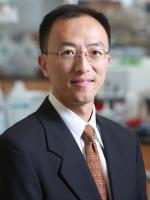Exploring Vascular Disease with 3-D Bioprinter

BioE Associate Professor Guohao Dai has developed a 3-D bioprinter to create tissue cultures for use in disease modeling and drug discovery.
Local Coverage: 3Ders.org, TCT Magazine
Source: News @ Northeastern
Nowadays, 3-D printed objects are ubiquitous, from toys to office supplies to coffee mugs. But new Northeastern faculty member Guohao Dai is pioneering this technology to bring bioengineering solutions to challenges in vascular biology. Specifically, he’s 3-D bioprinting live tissue with vascular perfusion.
Dai, associate professor in the Department of Bioengineering, has developed a 3-D bioprinter to create tissue cultures for use in human disease modeling and drug discovery. This is no small feat. As Dai explained, you can’t just take a commercial 3-D printer and start creating human tissue. It’s too harsh an environment. “It requires a very gentle process to build a live tissue,” he said. “If we use an industrial 3-D printer to print live tissue, all the cells would be dead.”
Dai’s research is focused largely on using bioengineering to generate insights into blood vessel regeneration and vascular disease. His 3-D printer—for which he developed both the hardware and software—can print tissues with small channels that function as blood vessels. His work hasn’t quite replicated human tissue yet, but, as he put it, “it’s one step toward fabricated tissue with blood flow.” In 2014 he received a National Science Foundation CAREER Award to advance stem cell research in this area.
To better understand disease, Dai is also funded by the National Institutes of Health and the American Heart Association to study the molecular differences between arteries and veins. Overall, the goal of his research is to provide a basis for developing novel therapeutic approaches to vascular-related disorders such as cardiovascular and neurovascular diseases and cancer progression in blood vessels.
It requires a very gentle process to build a live tissue. If we use an industrial 3-D printer to print live tissue, all the cells would be dead.
—Guohao Dai, associate professor of bioengineering
Dai comes to Northeastern from Rensselaer Polytechnic Institute, where he was an associate professor in the Department of Biomedical Engineering. He received his doctorate degree in biomedical engineering from the Massachusetts Institute of Technology and completed his post-doctoral training in vascular biology at Harvard Medical School. He received his master’s and bachelor’s degrees in biomechanics and mechanics, respectively, from Peking University in China.
Expressing excitement about joining the Department of Bioengineering, being in the heart of Boston—a city known for its world-class hospitals and healthcare innovation—and building interdisciplinary collaborations with colleagues both at and outside the university, he said: “I can’t even imagine how many opportunities are out there.”